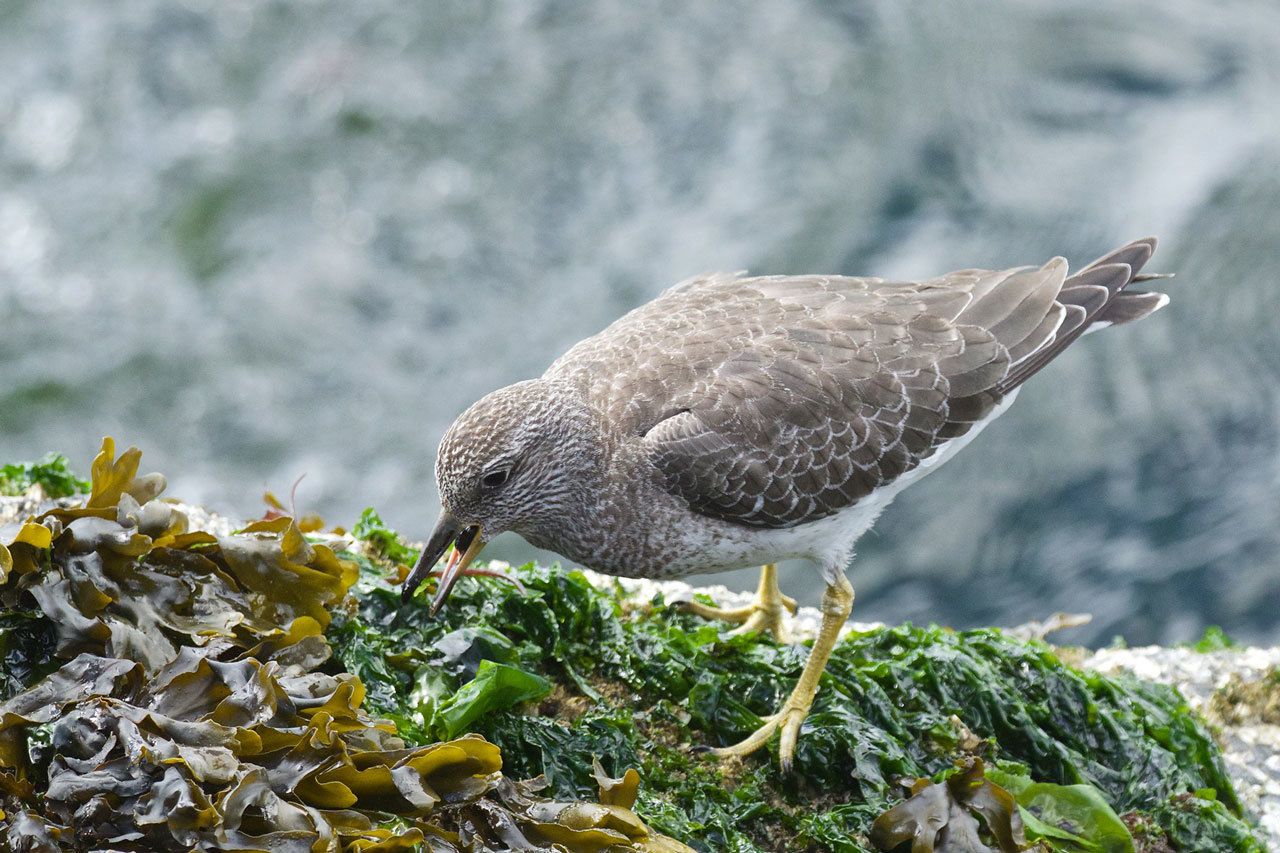After spending several days looking for this bird out at the jetty in Ocean Shores, I was surprised to see it is one of the more common birds to our area and should be a lot easier to find. I can only conclude it’s all about the luck of timing; some days luck is with you, some days it isn’t. Sound familiar? Gregg Thompson’s photo of a juvenile feeding is spot on for what we are seeing in the fall migration.
General Description: The Surfbird is a stocky shorebird with a short sturdy black bill with yellow at the base of the lower mandible. In fall plumage the adults have a gray upper body with mostly white bellies, and gray chevrons on the sides. The juveniles look the same but with white edges to their gray feathers. All ages have yellow legs. They about 10 inches in length, with a wingspan of 26 inches, and weigh about seven ounces. In flight, their tails are white with a black sub-terminal band, their inner wings are mostly white, and their upper wings have a broad slash of white from mid leading edge of the primaries back to the base of the tail.
Habitat: Surfbirds are a Pacific coast bird and spend most of their time within the splash zone, just feet from where the waves splash against the rocks of jetties and breakwaters. The only time of the year they are scarce locally is during breeding season when they are found in the mountains of Alaska and the Yukon.
Behavior: Surfbirds are found in small groups of other rock birds, such as Rock Sandpipers, Ruddy or Black Turnstones, and Wandering Tattlers. Their bill is used to pry food off the rocks as they scour the tideline.
Diet: Their diet most of the year is found on the rocks; limpets, small crabs, mussels, and barnacles, which they eat shell and all. In their summer breeding range they eat insects, spiders, and other invertebrates, and even seeds.
Nesting: Not much is known about the nesting habits of Surfbirds as they choose rocky ridges above the timber line, difficult to access for humans. They pair up shortly after arriving on the breeding grounds and a completely exposed nest is made on the ground in a small depression lined with lichen, leaves, and moss. It is believed the male does the incubating of two to four eggs for 22 to 24 days. The young leave the nest in two to four days and can feed themselves. It is unknown whether both adults tend the young or only the males, and also unknown when the young fledge.
Migration: The winter range of Surfbirds is as interesting as the bird itself, the longest and narrowest of any North American breeding bird…southern Alaska to southern Chile. In May, most of the population stages in Prince William Sound before heading into the interior mountains and their breeding territories.
Conservation Status: The Canadian Wildlife Service estimates the Surfbird population at 70,000 birds. They are considered at risk due to the concentration on their staging area at Prince William Sound where they can (and have) been exposed to petroleum residue, and to the increase of human population in their wintering coastal areas.
When and Where to Find in Grays Harbor: Surfbirds are considered common on the jetties and breakwaters around Grays Harbor. The easiest way to spot them is to watch where the incoming surf splashes on the rocks. The pattern of a white stripe across the gray upper wing is very clear. They are most often seen with Black Turnstones. Enjoy the splash zone.



